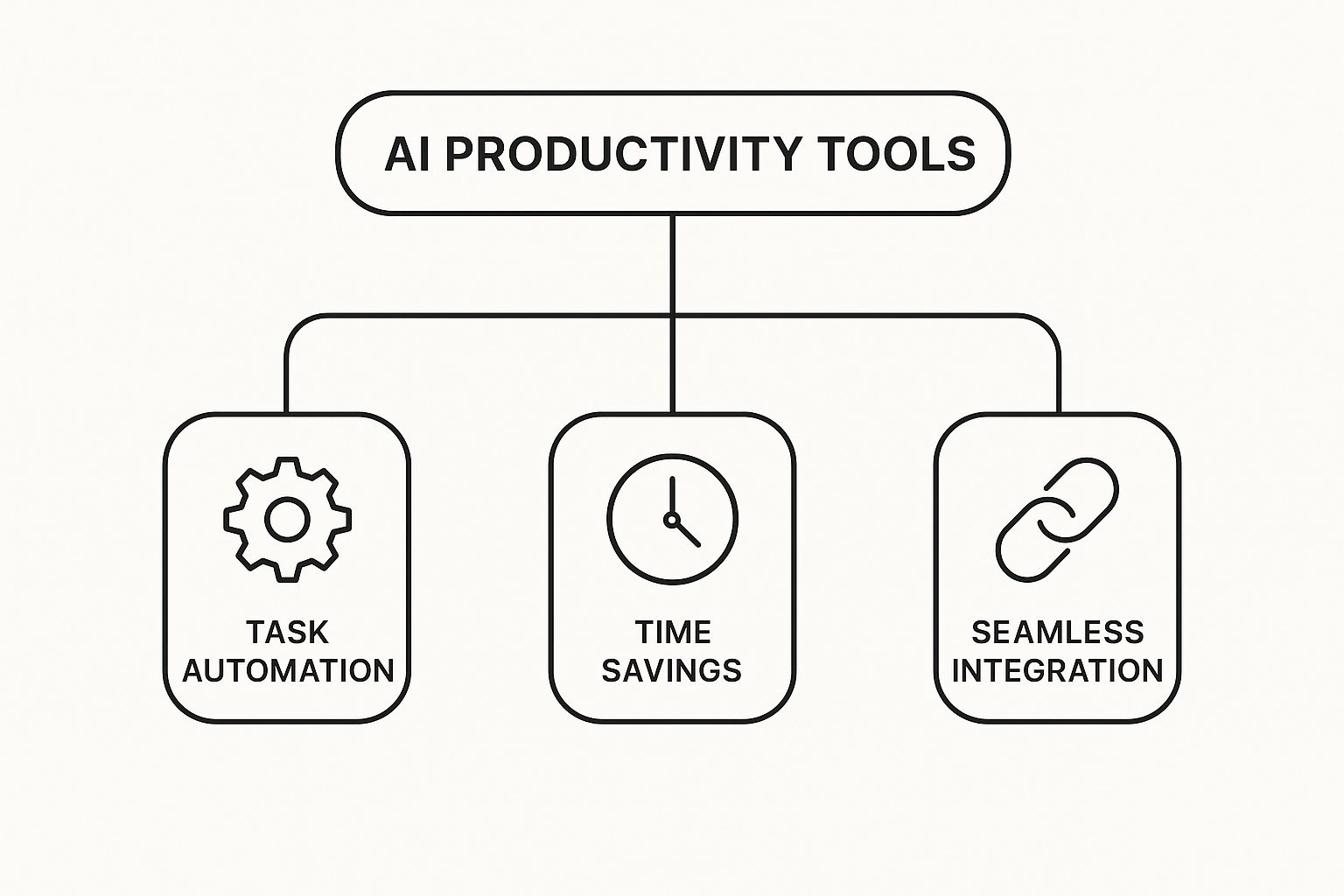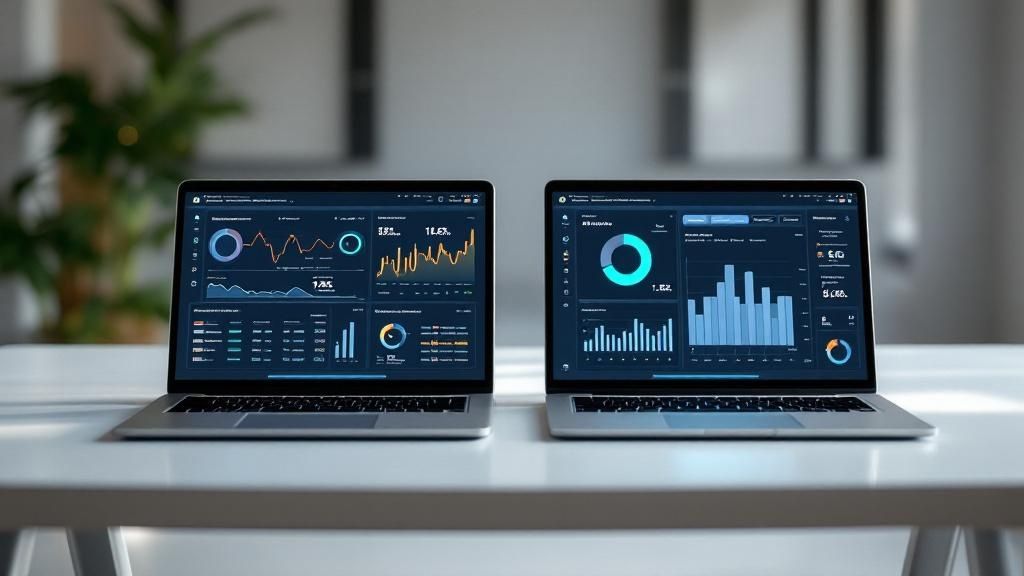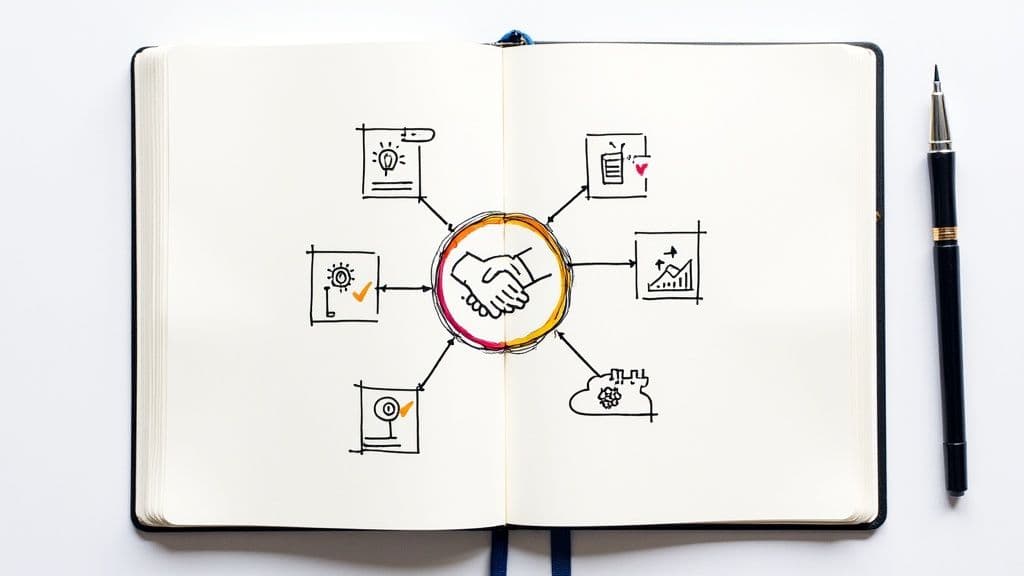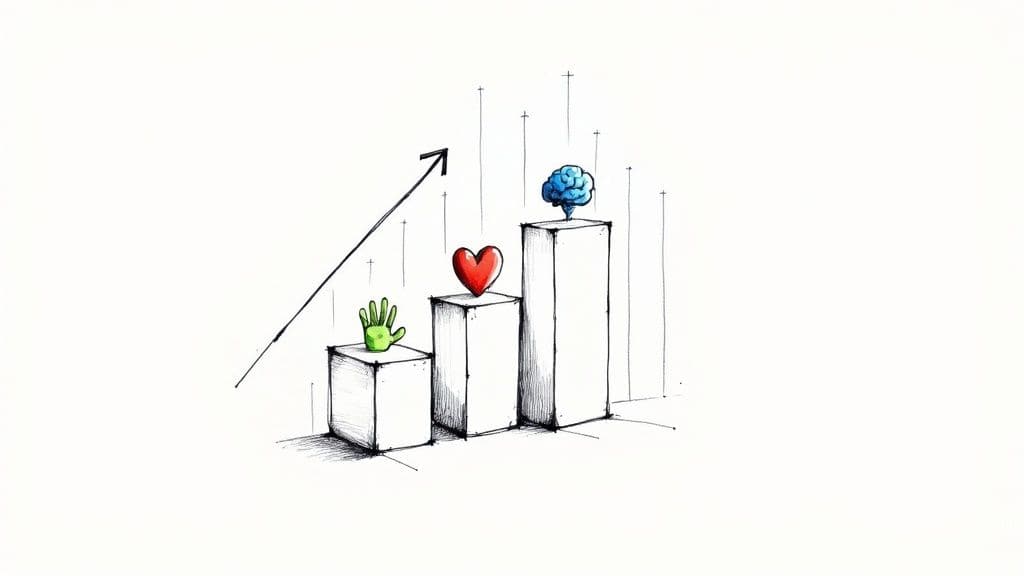AI Powered Productivity Tools for Modern Founders
Discover how AI powered productivity tools transform team workflows. Learn expert strategies to choose the right tools, boost efficiency, and drive alignment.
Let’s be honest. AI-powered productivity tools aren't just another app category. They are intelligent systems designed from the ground up to use machine learning to kill repetitive work, surface insights you’d otherwise miss, and untangle complex workflows.
Think of them less as tools and more as a way to supercharge your team's ability to focus on the high-impact work that actually moves the needle.
Moving Beyond Busywork with AI

The real challenge in any workplace today isn't the endless list of tasks. It's trying to maintain focus and stay aligned while drowning in digital noise. Your classic productivity hacks and to-do lists just aren't cutting it anymore. They’re great for managing activity, but they completely fail at connecting that activity to meaningful outcomes.
This is where AI-powered productivity tools change the game.
From Reactive Chaos to Proactive Clarity
These systems shift teams from a state of constant firefighting to one of proactive clarity. Instead of just checking boxes, they offer a fundamentally smarter way to operate. This isn't magic; it's just really good tech.
-
Machine Learning (ML): This is the brain of the operation. It allows the tool to learn from your team's data and workflows, spotting patterns to get smarter over time. For example, an ML-driven project manager might learn to flag which tasks are most likely to hit a snag before it happens.
-
Predictive Analytics: By crunching past performance data, these systems can forecast future outcomes with surprising accuracy. This helps leaders make smarter decisions, put resources where they’ll have the most impact, and get ahead of bottlenecks before they derail a project.
-
Natural Language Processing (NLP): This is the tech that lets AI understand and generate human language. It’s what powers features like automated meeting summaries, sentiment analysis on customer feedback, and those surprisingly helpful chatbot assistants.
Augmenting Human Potential
The real goal here isn't to replace your team. It's to augment their abilities. By handing off the grunt work and serving up data-driven insights, these tools free up your team's most valuable resource: their brainpower.
The core promise of AI in the workplace is to eliminate manual processes and administrative overhead. This empowers talented people to dedicate their energy to strategic thinking, creative problem-solving, and other high-value activities that machines can't replicate.
Ultimately, this shift allows your team to spend less time on "busywork" and more time on the innovative, meaningful work that actually drives progress and fuels real growth.
How AI Tools Redefine Team Productivity
To really get a grip on how AI powered productivity tools move the needle, you have to look past the buzzwords and see what’s happening under the hood. These tools do more than just manage your to-do list. They’re automating the grunt work, pulling smart summaries out of hour-long meetings, and even predicting project roadblocks before they happen.
Think about the difference between navigating with an old paper map and using a smart GPS. The map shows you the roads, sure. But the GPS spots traffic jams, finds faster routes on the fly, and adjusts in real-time. That’s the leap AI brings to your team—it shifts you from just reacting to problems to making smart, proactive decisions based on actual data.
This visual really breaks down the core benefits these tools bring to the table.

As you can see, automating simple tasks creates a direct line to massive time savings, all while plugging right into the way your team already works.
From Automation To Augmentation
At the most basic level, these tools are about automation. They take on all the repetitive, low-impact tasks that eat up your day—things like data entry, scheduling back-and-forth, and sorting through endless email chains. This first layer of efficiency frees up your team's headspace for work that actually requires a brain.
But the real magic happens when you move from automation to augmentation. The smarter tools use machine learning to analyze how your team works and spot inefficiencies you’d probably miss. They become an intelligent co-pilot, suggesting better workflows and helping your team work smarter, not just harder. If you're looking for more ways to get more out of your day, we have a whole guide on how to be more productive.
Predictive Insights And Proactive Strategy
The most advanced AI powered productivity tools are now getting into predictive analytics. By crunching data from past projects, they can forecast potential delays, flag tasks that are at risk of falling behind, and point out where you might be short on resources.
This completely changes the game for project management. Instead of just being a record of what went wrong, it becomes a forward-looking system that helps you get ahead of trouble. It’s the difference between reading a post-mortem report and preventing the need for one in the first place.
It's no surprise the market for these solutions is blowing up. Valued at USD 6.95 billion in 2023, the global AI productivity tools market is expected to rocket to USD 36.35 billion by 2030. That’s a staggering compound annual growth rate of 26.7%.
This explosive growth is a clear signal: businesses are racing to adopt AI to get more done with less burnout. And to get the most out of these tools, you need to see how they fit into the bigger picture of the top remote collaboration tools that modern teams rely on.
To make sense of the options, it helps to break them down by what they actually do for you.
Categories of AI Powered Productivity Tools
This table outlines the main types of AI tools teams are using, so you can figure out which category fits your specific needs.
| Tool Category | Primary Function | Example Use Case |
|---|---|---|
| Project Management | Automating task assignments, predicting timelines, risk ID | An AI flags a task as "at-risk" because a key dependency is behind schedule. |
| Communication & Collab | Summarizing meetings, transcribing calls, drafting emails | A tool generates a perfect summary of a Zoom call with action items. |
| Content Creation | Generating drafts, brainstorming ideas, editing text | Your marketing team uses an AI to create five different blog post outlines. |
| Data Analysis | Identifying trends, creating reports, visualizing data | An AI analyzes sales data and highlights the top-performing region. |
| Personal Productivity | Scheduling meetings, managing calendars, organizing notes | A personal AI assistant finds and books a meeting time that works for everyone. |
Each category solves a different piece of the productivity puzzle, from managing massive projects to simply getting your own schedule under control.
Choosing an AI Tool That Actually Works for Your Team

With a flood of AI powered productivity tools hitting the market, it’s easy to get lost in flashy features that don't deliver real value. Choosing the right one means looking past the marketing hype and focusing on how it will fit into your team’s daily reality.
A tool that creates more friction than it removes is a step backward, not forward. The goal is to find a system that amplifies your team's existing strengths without demanding a complete overhaul of how they work. After all, the best tool is the one your team will actually use.
Core Features That Drive Real Adoption
When you’re weighing your options, focus on three non-negotiable pillars that separate genuinely useful tools from temporary distractions. If a tool is missing even one of these, it can quickly become a source of frustration and wasted resources.
- Seamless Integrations: The tool has to play nice with your existing tech stack. If it can't effortlessly connect to Slack, Google Workspace, or your project management software, you're just creating another information silo.
- Intuitive User Interface (UI): A complicated interface is a death sentence for adoption. The best platforms are so intuitive they require almost no training, letting your team get value from day one.
- Actionable Insights, Not Just Data: Lots of tools can show you data. The best ones tell you what it means. Prioritize solutions that offer predictive insights—flagging risks, forecasting outcomes, and suggesting where to focus next.
A powerful AI tool shouldn't just present a dashboard of metrics; it should connect those metrics to strategic goals. It answers the question, "What should we do differently tomorrow based on what happened today?"
Even with the best tools, a fundamental problem often remains. Individual productivity apps are great at tracking tasks, but they frequently fail to answer the bigger question: are we all pulling in the same direction? Even with the best focus techniques, most teams struggle to know whether they’re actually making consistent progress toward shared goals.
SprintDojo solves this by combining daily win celebrations, weekly team reviews, and AI-powered forecasting into one alignment system. Research shows small wins are the #1 motivator for sustained team performance (Amabile & Kramer, 2011), and SprintDojo builds this into your team’s daily rhythm. By focusing on team alignment and goal forecasting, it ensures individual efforts consistently stack up to collective success.
The Great Disconnect: Why Being Busy Isn't the Same as Making Progress
Most productivity systems share a fatal flaw. They’re brilliant at helping you optimize tasks and feel busy, but they completely fail to connect that flurry of daily activity to the team's actual goals.
Even with the sharpest focus techniques, most teams end the week unable to answer one simple, crucial question: "Did all our hard work actually move the needle?"
This creates a dangerous gap between being active and being productive. Teams can check off 100% of their to-do lists and still miss their strategic targets by a mile. It’s in this disconnect that burnout festers and momentum dies, because all that effort never translates into tangible, celebrated wins.
The explosive growth of the AI-powered productivity tools market shows just how widespread this problem is. Valued at roughly USD 10.97 billion in 2024, the market is expected to surge to USD 25.95 billion by 2030. That’s not just growth; it’s a clear signal that teams are desperate for smarter systems that do more than just manage tasks. You can dive deeper into the AI productivity tools market growth on Virtuemarketresearch.com.
AI Isn't About Tasks, It's About Alignment
The real problem isn't a lack of effort. It’s the absence of a feedback loop connecting what you do today to where the team needs to be tomorrow. Without it, people operate in silos, just hoping their individual contributions somehow add up.
This is where a new breed of AI-powered productivity tools is changing the game by focusing on outcomes, not just output.
Think of these platforms as a central nervous system for your team. They provide a real-time view of how everyone's work is stacking up against the bigger picture. By analyzing progress patterns and spotting misalignments early, they give leaders the data to course-correct before a sprint goes off the rails. The conversation shifts from "What did you do?" to "What did we achieve together?"
Putting AI to Work in the Real World

The theory is one thing, but the real test of any AI powered productivity tool is how it actually performs on the ground. Let's make this concrete and look at how teams are actually using these systems to sharpen their game and get real results.
Think about a marketing team drowning in campaign data. Instead of spending days slogging through spreadsheets, they plug into an AI platform that crunches performance metrics in minutes. The tool doesn't just show them what content worked; it predicts which future topics will hit the mark, taking the guesswork out of their content strategy. That’s not just a time-saver—it’s a direct line to better ROI.
Accelerating Development and Delivery
In software development, speed and accuracy are everything. Dev teams are now using AI assistants that are basically intelligent co-pilots. These tools can spit out boilerplate code, suggest smarter algorithms, and even sniff out bugs before they ever see the light of day.
This slams the accelerator on development cycles. Teams ship features faster and with fewer headaches. The AI handles the grunt work, freeing up developers to focus on the complex, creative problem-solving that actually requires human genius.
AI's impact isn't just limited to the office, either. It’s also reshaping specialized roles. For example, recruitment automation is completely changing how companies find and hire top talent.
Connecting Effort to Outcomes for Remote Teams
For remote startups, keeping everyone aligned is a constant battle. How do you make sure everyone is pulling in the same direction when you can't just huddle in a conference room? This is where tools built for modern work really shine.
Many remote teams set ambitious goals but lose focus after the first sprint because daily work feels disconnected from the bigger picture.
SprintDojo’s AI-powered team alignment system helps remote and startup teams forecast goals and track progress without adding more meetings. Research is clear: seeing small, visible wins is the number one driver for staying motivated and keeping performance high. By tracking progress and highlighting where attention is slipping—before it costs you a deadline—SprintDojo helps teams stay focused. Everyone can see exactly how their work pushes the big goals forward, turning individual tasks into collective momentum. It keeps the whole team focused, aligned, and consistently hitting their targets.
Integrating AI Tools Without Disrupting Your Workflow
Bringing new tech into the mix can feel like a massive headache waiting to happen. But a smart rollout makes all the difference. The real goal isn't to force a new system on your team overnight. It's to find something that solves a genuine pain point so perfectly they’ll wonder how they ever got by without it.
A successful launch of any AI powered productivity tool always starts with a small, controlled experiment. Forget the big, company-wide announcement. Instead, pick a single pilot group—a small, motivated team that’s willing to be the guinea pig. This keeps the learning curve contained and lets you build an internal success story. Soon enough, you'll have champions who can help you roll it out to everyone else.
Start with the Problem, Not the Tool
Before you even glance at a feature list, get crystal clear on the one specific problem you're trying to fix. Is project forecasting a nightmare? Is keeping the team aligned a constant battle? Frame the new tool as the specific answer to that specific challenge.
This simple shift changes everything for your team. The AI isn't just "another tool to track what we do"; it's a way to make their work easier, more meaningful, and way less frustrating. When people see how it directly smooths out the rough spots in their day-to-day, genuine buy-in just happens.
The best AI integrations feel less like a top-down mandate and more like a solution to a shared headache. It’s about giving your team a better way to win, not just watching their every move.
This focus on solving real business problems is exactly why the market is exploding. The AI productivity tools market is on track to grow by over $25 billion between 2025 and 2029, powered by an incredible CAGR of nearly 28%. This isn't just hype; it’s a direct response from teams demanding smarter, better ways to work. You can dig into more of the data in a detailed market report on Technavio.org.
For instance, if your biggest issue is not knowing where projects stand each week, a tool that automates status updates can be a total game-changer. It gets rid of those soul-crushing check-in meetings, a key principle of any solid weekly review template. By prioritizing tools that slot right into your workflow and solve a real need, you get all the benefits of AI without the chaos of a botched rollout.
Common Questions About AI Productivity Tools
When founders and team leads start digging into AI-powered productivity tools, the same handful of crucial questions always come up. Getting straight, real-world answers is the only way to feel good about the tools you bring into your team's workflow.
Are AI Tools Secure for Company Data?
Security isn't just a feature; it's the foundation. And let's be clear: not all tools are built the same.
You need to be ruthless about finding platforms with enterprise-grade security protocols. Look for non-negotiables like end-to-end encryption and data privacy policies you can actually understand. If a vendor is vague about how your data is used, stored, or protected, walk away.
Here’s the biggest red flag: any gray area around data ownership. Your team’s data is yours, period. The tool's terms of service should scream this from the rooftops.
How Quickly Can We See a Return on Investment?
The ROI from AI-powered productivity tools doesn't just show up once; it hits in two very different waves.
The first wave is almost instant. You’ll feel it right away in time saved on small, repetitive tasks—think automated meeting summaries or pulling data for reports. These are the quick wins that give your team breathing room.
The second wave is deeper and builds over a few weeks. This is where the real magic happens. You start seeing massive strategic gains in team alignment, your goal forecasting gets scarily accurate, and projects stop drifting off course. While this ROI takes a few sprints to measure, its long-term impact on hitting your most ambitious goals is where the real value is hiding.
Will These Tools Make Project Managers Obsolete?
This is the question on everyone’s mind, but the answer is a hard no. AI tools don't replace project managers—they supercharge them.
By taking over the administrative grind and the heavy analytical lifting, these systems free up managers from the soul-crushing work of chasing updates and building reports.
This is a game-changer. It lets them shift their focus from being taskmasters to becoming true strategic leaders. They get to spend their energy on the stuff that actually matters: mentoring their team, navigating complex challenges, and making the kind of high-level decisions that no algorithm can ever replicate.
Sprint Smarter. Forecast Every Week.
Log wins. Build momentum. Let AI show you if you're on track to hit your sprint goal—before it's too late.
Join the waitlist and be the first to unlock predictive clarity for your team.

